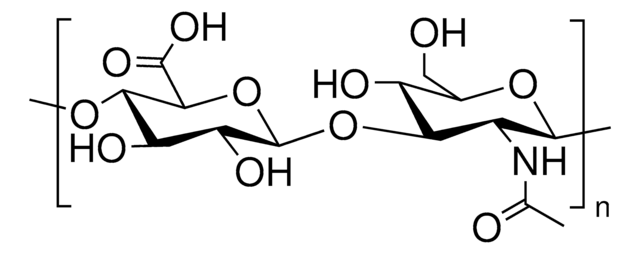The linear formula for hyaluronic acid sodium salt is [C14H22NNaO11]n where n is the number of monomeric units present in the polymer. This would equate to 403.31 g/mol for each unit. Hyaluronic acid has the linear formula [C16H27NO11]n which would have a molecular weight of 409.39 per unit.
53747
Hyaluronic acid sodium salt from Streptococcus equi
bacterial glycosaminoglycan polysaccharide
Synonym(s):
Poly(β-glucuronic acid-[1→3]-β-N-acetylglucosamine-[1→4]), alternating
About This Item
Recommended Products
biological source
(Streptococcus equi)
form
powder or crystals
mol wt
~1.5-1.8 x 10E6 Da
impurities
≤1% protein
color
white
solubility
H2O: 5 mg/mL, clear, colorless
storage temp.
−20°C
SMILES string
[Na+].CC(=O)N[C@@H]1C[C@H](O)[C@@H](CO)O[C@H]1O[C@H]2[C@H](O)[C@@H](O)[C@H](O)O[C@@H]2C([O-])=O
InChI
1S/C28H44N2O23.Na/c1-5(33)29-9-18(11(35)7(3-31)47-25(9)46)49-28-17(41)15(39)20(22(53-28)24(44)45)51-26-10(30-6(2)34)19(12(36)8(4-32)48-26)50-27-16(40)13(37)14(38)21(52-27)23(42)43;/h7-22,25-28,31-32,35-41,46H,3-4H2,1-2H3,(H,29,33)(H,30,34)(H,42,43)(H,44,45);/q;+1/t7-,8-,9-,10-,11-,12-,13+,14+,15-,16-,17-,18-,19-,20+,21+,22+,25-,26+,27-,28-;/m1./s1
InChI key
YWIVKILSMZOHHF-QJZPQSOGSA-N
General description
Application
- with methacrylic anhydride for synthesizing cross-linkable methacrylated HA hydrogel (Coll-MeHA)
- in phosphate buffer saline (PBS) to replace the PBS bath to vary the lubricant composition
- in the preparation of lubricant to study its effects on the boundary lubrication of human osteoarthritis (OA) cartilage
Biochem/physiol Actions
Other Notes
Storage Class Code
11 - Combustible Solids
WGK
WGK 2
Flash Point(F)
Not applicable
Flash Point(C)
Not applicable
Choose from one of the most recent versions:
Already Own This Product?
Find documentation for the products that you have recently purchased in the Document Library.
Customers Also Viewed
Articles
Uncover more about glycosaminoglycans and proteoglycans including the structure of glycosaminoglycans (GAGs), the different types of GAGs, and their functions.
Uncover more about glycosaminoglycans and proteoglycans including the structure of glycosaminoglycans (GAGs), the different types of GAGs, and their functions.
Uncover more about glycosaminoglycans and proteoglycans including the structure of glycosaminoglycans (GAGs), the different types of GAGs, and their functions.
Uncover more about glycosaminoglycans and proteoglycans including the structure of glycosaminoglycans (GAGs), the different types of GAGs, and their functions.
-
May I know the formula and MW for one unit of Hyaluronic acid? And I also need the formula and MW for one unit of Hyaluronic acid Sodium. Thanks!
1 answer-
Helpful?
-
-
How is shipping temperature determined? And how is it related to the product storage temperature?
1 answer-
Products may be shipped at a different temperature than the recommended long-term storage temperature. If the product quality is sensitive to short-term exposure to conditions other than the recommended long-term storage, it will be shipped on wet or dry-ice. If the product quality is NOT affected by short-term exposure to conditions other than the recommended long-term storage, it will be shipped at ambient temperature. As shipping routes are configured for minimum transit times, shipping at ambient temperature helps control shipping costs for our customers. For more information, please refer to the Storage and Transport Conditions document: https://www.sigmaaldrich.com/deepweb/assets/sigmaaldrich/marketing/global/documents/316/622/storage-transport-conditions-mk.pdf
Helpful?
-
-
How can I determine the shelf life / expiration / retest date of this product?
1 answer-
If this product has an expiration or retest date, it will be shown on the Certificate of Analysis (COA, CofA). If there is no retest or expiration date listed on the product's COA, we do not have suitable stability data to determine a shelf life. For these products, the only date on the COA will be the release date; a retest, expiration, or use-by-date will not be displayed.
For all products, we recommend handling per defined conditions as printed in our product literature and website product descriptions. We recommend that products should be routinely inspected by customers to ensure they perform as expected.
For products without retest or expiration dates, our standard warranty of 1 year from the date of shipment is applicable.
For more information, please refer to the Product Dating Information document: https://www.sigmaaldrich.com/deepweb/assets/sigmaaldrich/marketing/global/documents/449/386/product-dating-information-mk.pdfHelpful?
-
-
Is this suitable for sterile use or should it be sterilized and how would you recommend to sterilize?
1 answer-
TS Answer: This product is not sterile, however, prepared stock solutions may be autoclaved or filter-sterilized. The estimated molecular weight range is 0.85 to 1.6 million daltons. Filtration studies of high molecular weight HA have not been performed, however, various literature sources suggest the use of a PES filter membrane would be the best option. There are a number of product alternatives available, such as the Steriflip-GP product SCGP00525 - see the link below to review this product.
https://www.sigmaaldrich.com/US/en/product/mm/scgp00525
Alternatively, HA can be added directly to the medium prior to filtration for tissue culture applications. See the link below to review a publication demonstrating this process:
https://pubmed.ncbi.nlm.nih.gov/35907556/Helpful?
-
-
How should product 53747 be stored after it is resuspended in solution?
1 answer-
Following reconstitution, refrigerate (4°C). Stock solutions are stable for up to 3 months at 4°C.
Helpful?
-
-
What is the molecular weight of this hyaluronic acid, in units of g/mol?
1 answer-
The molecular weight of this product, based on viscosity, generally ranges from 1.3 - 1.8 MDa, but can be as high as 2.5 MDa.
Helpful?
-
-
このヒアルロン酸を水に溶かして1mg/mLの溶液を作製しました。摩ル濃度(mol/L)を計算するにはどうすればよいですか?
1 answer-
The molecular weight of this product, based on viscosity, generally ranges from 1.3 - 1.8 MDa, but can be as high as 2.5 MDa. At a concentration of 1 mg/ml the molarity may be in the range of 6.6-5.5 X 10E-7 mol/L. This is only an estimation due to the variable molecular weight.
Helpful?
-
-
How should I store Product 53747, Hyaluronic acid sodium salt from Streptococcus equi?
1 answer-
This product should be stored at - 20 °C.
Helpful?
-
-
What is the molecular weight of Product 53747, Hyaluronic acid sodium salt from Streptococcus equi?
1 answer-
According to our supplier, the molecular weight of Product 53747 is approximately 1.5 to 1.8 X 10E6 Dalton.
Helpful?
-
-
Can Product 53747, Hyaluronic acid, be sterilized?
1 answer-
Yes, according to references you can autoclave Hyaluronic acid sodium salt from Streptococcus equi.
Helpful?
-
Active Filters
Our team of scientists has experience in all areas of research including Life Science, Material Science, Chemical Synthesis, Chromatography, Analytical and many others.
Contact Technical Service

